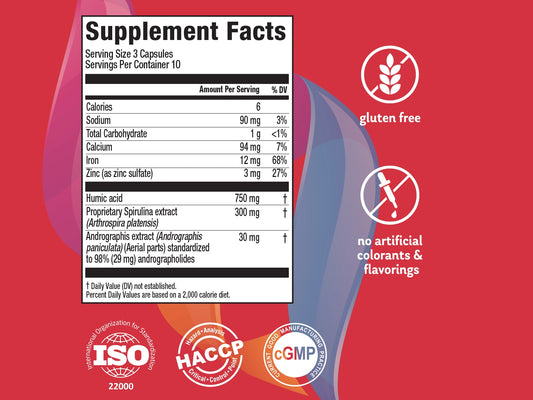Andrographis paniculata (also called “Indian echinacea” or “king of bitters”) has been used for thousands of years in China and Thailand, and has recently become increasingly popular in both the United States and Scandinavia.
Scientific research has shown that Andrographis paniculata and its main compound, androgarpholides, have many benefits for normal immune health16,17.* Some studies suggest that andrographis may also have a beneficial effect on the upper respiratory tract, and help maintain seasonal wellness1,2,6,8.* Andrographolides, a diterpenoid lactone derived from the roots and leaves of Andrographis paniculate, helps maintain the levels of immune cells in the blood10,17.* More than 30 substances such as lactones, flavonoids, and flavonoid glycosides, including diterpenoids, can be extracted from the stems and leaves of Andrographis paniculata. Widely used for its antioxidant properties, the plant has also been shown to have a beneficial effect on the cardiovascular and digestive systems1,8.*
- Coon JT, Ernst E. Planta Med. 2004;70(4):293-298. doi:10.1055/s-2004-818938
- Wang W, Wang J, Dong S, et al. Acta Pharmacol Sin. 2010;31(2):191-201. doi:10.1038/aps.2009.205
- Saxena RC, Singh R, Kumar P, et al. Phytomedicine. 2010;17(3-4):178-185. doi:10.1016/j.phymed.2009.12.001
- Poolsup N, Suthisisang C, Prathanturarug S, Asawamekin A, Chanchareon U. J Clin Pharm Ther. 2004;29(1):37-45.
- Gabrielian ES, Shukarian AK, Goukasova GI, et al. Phytomedicine. 2002;9(7):589-597. doi:10.1078/094471102321616391
- Caceres DD, Hancke JL, Burgos RA, Wikman GK. Phytomedicine. 1997;4(2):101-104. doi:10.1016/S0944-7113(97)80051-7
- Panossian A, Davtyan T, Gukassyan N, et al. Phytomedicine. 2002;9(7):598-605. doi:10.1078/094471102321616409
- Samy RP, Thwin MM, Gopalakrishnakone P. Nat Prod Commun. 2007;2(5):1934578X0700200519. doi:10.1177/1934578X0700200519





